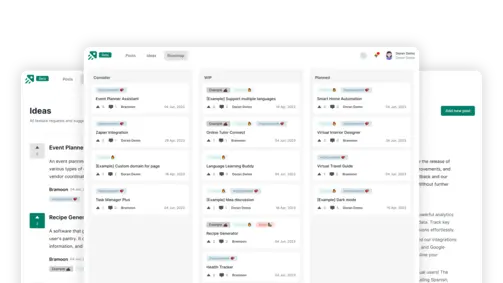CSAT Survey Analysis: Unveiling Insights for Improvement
Create changelog and product roadmap for your product
Explore nowTable of contents 6 min
- What is CSAT Analytics? Understanding CSAT Survey Analysis.
- How Do CSAT, NPS, and CES Differ From One Another?
- Importance of Analyzing CSAT Survey Data
- How to Analyze Customer Satisfaction Survey Data
- Techniques for CSAT Survey Analysis
- A Good CSAT Score: What Is It?
- Leveraging CSAT Survey Analysis for Improvement
Analyzing CSAT (Customer Satisfaction Score) survey data is a crucial first step in gaining insight into customer sentiment and promoting continuous improvement in the context of customer satisfaction measures. The purpose of this in-depth guide is to examine the approaches, tactics, and importance of CSAT survey analysis. Businesses can gain practical insights to improve their services, goods, and overall consumer experiences by delving into the nuances of CSAT analytics.
What is CSAT Analytics? Understanding CSAT Survey Analysis.
Customer satisfaction levels with your business are directly questioned in CSAT surveys.
CSAT surveys are sent at a touchpoint (such as after a purchase or after a customer care encounter) that your team determines needs a temperature check. They can be asked via email, live chat, or in-app.
An illustration of a CSAT question
“How satisfied were you with your recent (interaction, purchase, upgrade, etc)?”
Next, on a scale ranging from Extremely Unsatisfied to Extremely Satisfied, respondents will make their selection. Although there are other options, the 5- or 10-point scale is most frequently used to measure CSAT.
CSAT analytics refers to the process of using data analysis techniques to derive actionable insights from CSAT survey data. It involves employing statistical, qualitative, and segmentation analysis methods to understand customer satisfaction trends and drivers.
How to Determine Your CSAT Score
You will need to do some simple math after you receive your CSAT responses in order to determine your CSAT score.
Divide the total number of respondents by the number of respondents who scored a 4 or a 5, meaning that they replied positively or extremely positively.
Once you multiply that figure by 100, you will obtain your proportion of happy clients. This is the formula:

For instance, your score would be 75 if 100 respondents completed your survey and 75 of them rated you either a 4 or a 5 out of 5.
Score on the CSAT: (75/100) x 100 = 75
Find out more: How to Collect Customer Feedback Effectively
How Do CSAT, NPS, and CES Differ From One Another?

Customer Effort Score (CES), Net Promoter Score (NPS), and CSAT are all metrics used to assess customer happiness, but they serve distinct purposes.
While Net Promoter Score provides macro-level insights on customer loyalty to your business, CSAT provides micro-level insights on customer satisfaction with a product or service. Customer Effort Score, on the other hand, gauges how simple it is for users to utilize a service or product or to fix an issue.
Importance of Analyzing CSAT Survey Data
Analyzing CSAT survey data is crucial for businesses aiming to:
-
Measure Customer Satisfaction: Assessing satisfaction levels provides a clear picture of how customers perceive products, services, or interactions.
-
Identify Pain Points: Pinpointing areas where customers are dissatisfied helps in focusing efforts for improvement.
-
Drive Decision-Making: Data-driven insights derived from CSAT analytics aid in making informed decisions to enhance customer experiences.
How to Analyze Customer Satisfaction Survey Data
-
Data Collection and Organization: Gather CSAT survey responses systematically, organizing them for ease of analysis. Use tools or software to compile and manage data efficiently.
-
Quantitative Analysis: Utilize statistical methods to quantify satisfaction scores, calculate averages, and identify trends or patterns in responses.
-
Qualitative Analysis: Analyze open-ended responses to derive qualitative insights. Use sentiment analysis tools to understand customer sentiments and opinions.
-
Segmentation Analysis: Segment data based on demographics, product usage, or other criteria to identify specific areas of concern or satisfaction.
Techniques for CSAT Survey Analysis
-
Trend Analysis: Track CSAT scores over time to observe changes and patterns in customer satisfaction levels.
-
Benchmarking: Compare CSAT scores against industry standards or competitor benchmarks to gauge relative performance.
-
Root Cause Analysis: Identify underlying reasons for low or high CSAT scores by delving deeper into specific customer feedback.
-
Correlation Analysis: Explore relationships between different variables to understand how factors influence customer satisfaction.
Read more: 9 Customer Feedback Software: Small to Enterprise Business
A Good CSAT Score: What Is It?

At this point, if you are doing this for the first time, you will undoubtedly have questions. You know your score, but what precisely makes a “good” CSAT score?
That varies, though. As a touchpoint assessment, which gauges sentiment at a certain moment in time, CSAT ratings are most helpful when applied as comparisons.
By comparing your recent scores with your previous ones, you may monitor your development.
On a few fundamental words, there is considerable consensus, nevertheless.
Businesses should first consider CSAT results within the framework of their respective industries. The average CSAT score in the United States in 2021 was 73.6%, according to the American Customer Satisfaction Index (ACSI), which is in the business of doing this kind of thing.
For example, if your company is in the finance and insurance sector and your CSAT is at 75%, you may take this as a positive indication, but in reality, it is below the industry average of 76%.
There are even bigger differences. For example, the Luxury Hotel Industry has such high rankings (Marriott 80%, Hilton 83%), that hotel companies use them in their advertising campaigns. Hard-to-please industries like hospitals, at 70%, and television subscription services, or cable, at 65%, are the exception.
The main idea is that you can obtain a personal “good CSAT score” via benchmarking, or assessing CSAT in relation to industry and time.
Leveraging CSAT Survey Analysis for Improvement
-
Addressing Pain Points: Use insights from CSAT survey analysis to prioritize and address areas where customers express dissatisfaction.
-
Enhancing Customer Experience: Implement changes based on feedback to improve products, services, or processes.
-
Continuous Monitoring: Regularly analyze CSAT data to track improvements and adapt strategies to evolving customer needs.
-
Employee Training and Alignment: Utilize insights to train staff, aligning their actions with customer expectations for better service delivery.
CSAT survey analysis is a powerful tool that empowers businesses to decipher customer sentiments and make informed decisions to enhance satisfaction. By employing various analytical techniques and strategies, organizations can gain valuable insights into customer preferences, pain points, and overall satisfaction levels. CSAT analytics serves as a guiding force, enabling businesses to continuously evolve, improve, and deliver exceptional experiences that foster long-term customer loyalty and sustained success.
What to not miss out on our blog
Gain insightful knowledge and invaluable experiences from dedicated experts.

CRM System Explained: Benefits, Types, and How It Works
Discover everything about CRM system. Learn the benefits and how a CRM system works to improve customer relationships and streamline business operations.

Are you ready? Start your free trial today.
Enhance communication, keep track of the progress, understand customers' insight and more by taking your first trial on Doran.
Sign up for free

